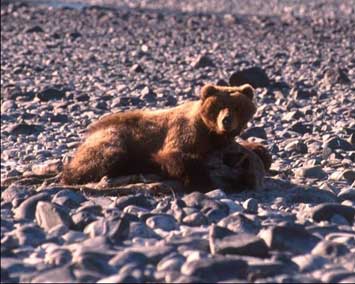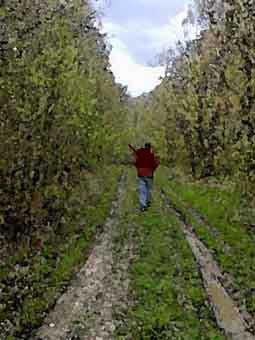


Jim Oltersdorf
Soldotna, Alaska
There can be no death any more horrifying than one of a bear attack. Even
the mere thought of a bear mauling a person sends shivers to the most seasoned
and experienced outdoorsman. It addresses a pronounced deep and primal fear
within all humans, the fear of being killed by a wild animal. Yet as terrifying
as that thought is, that is exactly what happened to Ken Cates in Soldotna,
Alaska on a seemingly innocent spring afternoon on Tuesday, May 25th, 1999.
At exactly 12:00 noon he told his wife of 35 years that he was going to go
for a hike and would be back around four o'clock. He would never return.
Ken Cates was as Alaskan as anyone could be, he worshiped the time he went hunting, hiking, fishing and simply enjoying the out-of-doors. A carpenter by trade, this slender, 5' 10" tall rugged man was just 53 years old and in excellent physical shape. He spent much of his youth and adulthood in many remote areas of the bush, it was a place where he could think without being disturbed.

Bear Attack
Experienced in the ways and wisdoms of the wilds, Cates became an expert marksman and reloaded his ammunition at his home in his basement when he was unable to go to the bush. In over forty-five years of trekking in Alaska, Cates never had a bad encounter with a bear. He hunted moose and caribou with a great deal of success and was known to pass up a shot if he couldn't kill the animal humanely. He had a select group of friends that he would hunt with and if that wasn't possible or he decided to hunt alone, off he would go.
On one of those hunts he told his wife, Sharon, that he was after moose and would be back later. That night when she was sound asleep, she was suddenly awakened by Ken standing next to their bed, soaked with blood. He had shot a moose and was very happy about it. She thought he had been seriously hurt with all of the blood on him, scaring her half to death.
Cates was a religious man and loved to attend church on Sundays. His desire to help the folks around the small Soldotna community was well know. On one Christmas, the Cates family had a get together with friends at their home. A number of people noticed that he would disappear out of the house for a while and then come back. Later, Sharon discovered that an elderly couple who lived by them required assistance to use the rest room. Ken was sneaking out to go over to their house to help carry them into the bathroom. That's just the kind of man he was, always helping somebody.
On the other side of Ken's personality was an entirely different man. He was a loner, a very quiet man who said few words but excelled at most everything he worked at. His name was well known in the inner circles of the construction trade. He had worked jobs as a foreman as far away as Anchorage on projects that required many skills. Ken was going to retire from his work that week, he and Sharon had talked about building their dream home in Soldotna and looked forward to living out their retirement days in Alaska. But that all changed that fateful day last spring when he decided to take a quick hike up the Funny River trail that is 6 miles east of town.
Sharon Cates knew that if he said he would be gone a short while that he was headed down to the Funny River area, a part of the Kenai Wildlife Refuge. This vast wilderness area is wild, roadless and lies south of Anchorage in the Kenai Peninsula. Although the huge Alaska Brown Bears are known to inhabit the area, few problems have occurred because of their presence. One of the reasons for this is that immense numbers of salmon spawn in the world-famous Kenai River and are eaten by the bears. With their bellies full, the bears usually pay no attention to the humans and are interested in only the fish.

Bear Attack
On the day of the killing, the weather was a typical Alaskan spring day on the peninsula. Although cloudy, the mid-fifty degree temperature sounded good to Cates after the long dark winter that had been endured. Leaving the house right at noon he told her to go with her girlfriend to the store and see about buying some flowers that she had said she wanted. Shouldering his camouflaged backpack, MSR cook stove, an igniter that Sharon had bought him to light the stove, a package of Ramen noodle soup and his ever-present Winchester .280 bolt action rifle, Cates set off to the Funny River Trail.
Later in the day, Sharon somehow sensed that something was amiss. When Ken didn't arrive home at 4:00 p.m. she became concerned, two hours later, she became even more worried and decided to go look for him. She and a friend went to the Funny River area and found his truck parked off the road at the trailhead. He wasn't there. A neighbor gave Sharon a cell phone to use just in case she needed it. She called the Alaskan State Troopers at 10:00 p.m. and their initial response was in many cases a hiker becomes lost on the maze of trails and usually arrives back late but no worse for wear. This was not to be the case in this instance.
Sharon placed numerous phone calls to all of Ken's hunting buddies and friends to aid in the search. Commencing early the following morning, approximately forty different people and various official agencies assembled to began their search for Ken Cates in earnest. Those that knew him were painfully aware that Ken was in trouble; he was too experienced to become simply lost on a trail that he had been on countless times over the years. He was not the type of man that would find himself in trouble out in the Alaskan bush.
At daybreak several of his hunting buddies started up the 18 inch wide muddy trail and discovered his size 10 1/2 boot prints. They also discovered something else that horrified them; a huge set of bear prints were on the same trail, overlapping his boot prints, headed in the same direction as he was walking. The weather had turn foul and a drizzle had started in the yet-to-foliage-out trees. The authorities had notified the Civil Air Patrol and with an airplane, they were airborne in the search as well.
Approximately 2 miles up the Funny River area trail, there is a sharp bend 90 degrees to the right and that's where they found Ken Cates body. He was laying on his back with the Winchester several yards away. It had been fired twice, a spent shell on the ground and the last-fired shot still in the chamber. The third and last shell was still in the magazine, unfired. He was bitten on his head, a single bite through his skull plate (from directly behind as forensics testing would prove later) crushing his skull and killing him instantly. He never had another second to fire the third round; it happened that quickly.
Cates’ MSR stove was sitting on the ground, a pan of water on it as if he was preparing a cup of Ramen soup to eat for his lunch when the attack happened. He had already stopped, which indicates that he didn't run into the bear; the bear ran into him. However, discrepancies still haunt the attack and there is only one thing for sure about really what happened.
Only Ken Cates and the bear know for sure what occurred that day on the Funny River trail in Soldotna, Alaska. What the authorities do know, however, is that although the killing scene was relatively undisturbed, forensic evidence proved that it was indeed a bear that had attacked and killed him. Hair found on a nearby tree has proven it to be from a bear. There is one other chilling piece of evidence as well. Close inspection of that same tree revealed bear blood. Reconstruction of the attack in his final moments showed Cates had indeed shot the bear. No one knows where the bruin was hit, but the blood validates it was hit by at least one of his .280 bullets, perhaps both. After Cates’ final shot, the bear killed him. To this day, the bear has never been found. One thing that is known for sure, is that the murderous bear is out in the woods somewhere; dead or very much alive.
An active ground and aerial search by citizens and officials alike for the bear had produced no results. Because of the ever-present rain, any credible evidence or links to the bear vanished. When the bears tracks were first discovered in the mud over the tracks of Cates’ boot prints, many people speculated that the bear had actually stalked it's prey until it was at it's most vulnerable position. In this case it would have been exactly what Cates was doing, sitting down and intent upon making his lunch, gun resting nearby or perhaps even out of immediate reach.
An Alaskan Brown, as with most other predators, kills by the method of least resistance. By killing this way there is less chance of injury to the predator when the attack takes place, most of the time. In some cases, the predator makes a mistake in judgement of distance to be covered, slips and one or more seconds are gained by the prey to act. Perhaps this was the case when Cates first saw the attacking bear, giving him enough time to snatch his Winchester from where he had leaned it and shoot at the charging beast in those possible life-saving last few seconds. Maybe he was standing and holding his rifle when he first saw the bear and fired a warning shot just to scare it off and subsequently it charged and gave him no other choice but to fire at point blank range.
As most people are aware, a sow with cubs is one of the most dangerous animals on earth if you get between them. In a blink of an eye, the bear will charge and leave no time to climb a tree, blast a noseful of pepper spray or take a gun and aim to shoot it. As with elk, deer, moose and other large game species, mother and offspring are in the general area of each other but not always side-by-side. Because of their playful nature, bear cubs are very susceptible to being a distance from the sow. Every tree, limb, grass, root, insect, and scurrying rodent captures the cubs’ attention and causes distances to increase. Maybe Cates had sat down for his meal and inadvertently sat or stood between them. When the Brown sow realized there was an interloper, she immediately charged and took a round or two before she knocked him down, causing him to lose his rife and therefore preventing him to shoot the one last cartridge. Perhaps as he was crawling to get his gun the bear crashed over the top of him and delivered the bite that killed him. Wounded, the bear crawled off to die in an impenetrable area of brush and forest, never to be found.
An Alaskan Brown bear can run faster than the fastest Olympian sprinter. Covering ground at over 35 miles per hour, the Brown can shorten a safe distance to a death sentence in seconds. Perhaps that's what happened in the Cates killing. What dumbfounds many residents about the bear killing this man is the known abilities that he had. For years Ken Cates had spent countless hours in the Alaskan bush, hunting, trekking and enjoying the entirety of it. Could a bruin have accidentally blundered into Cates while lumbering down the muddy Funny River trail and had no intent of killing him until it perceived him as a threat?

Bear Attack
An Alaskan Department of Fish and Game spokesman indicated there are many theories about what happened out there that day and, because of the lack of evidence, we may never know what exactly happened. Yet, despite exhaustive searches involving many people for the bear, not a single person has been mauled or killed in the area, leading speculation to believe the bear is dead from Cates’ bullet. Maybe the last courageous act of Ken Cates life was to serve him later, that indeed the last trigger squeeze he made on his Winchester did eventually kill his killer. Maybe not. One last scenario of the killing may include a chilling premeditated conclusion to Ken Cates life.
One of the facts to this story is the bear tracks that were found in the mud atop Cates’ boot prints on the trail were that of a very large bear according to eyewitnesses. The large size indicated it would have to have been made by a boar. In the event that the food chain had reversed itself by a single thought on behalf of the bear, it could have scented Cates, saw him as an easy meal and stalked him quietly and as efficiently as a Bengal tiger would. An interesting fact that was found back on the trail was the bear had made a dig next to the trail, uncovering the moss, dirt and twigs. It strikes a note of oddness that the bear would do something like that unless motivated by something. What was that something?
A known behavior in bear country is that a Brown will make a dig when a human urinates on the earth. Perhaps Cates relieved himself off the trail and continued walking toward the spot he would later pick to sit on the log and fix lunch. When the bear came out of the woods and started down the same trail, it came across the place where Cates went, smelled the human order and made the dig. Perhaps the bear's interpretation of that single innocent act of Cates set into motions the horrifying attack and terrible death. If that belief held, then the bear would have had to know that Cates was nearby. If it was the type of bear that had a great fear of humans, it would have fled the area, not followed the scent of man closer. Which opens the subject of critical exchange of thought. If the bear knew Cates was nearby on the trail and deliberately continued walking toward him, then it had bad things on its mind for Cates. If the bear was intent upon murdering Cates and had decided to do so, then this monster did its job well.
THE END
Jim Oltersdorf/Writer/Photographer